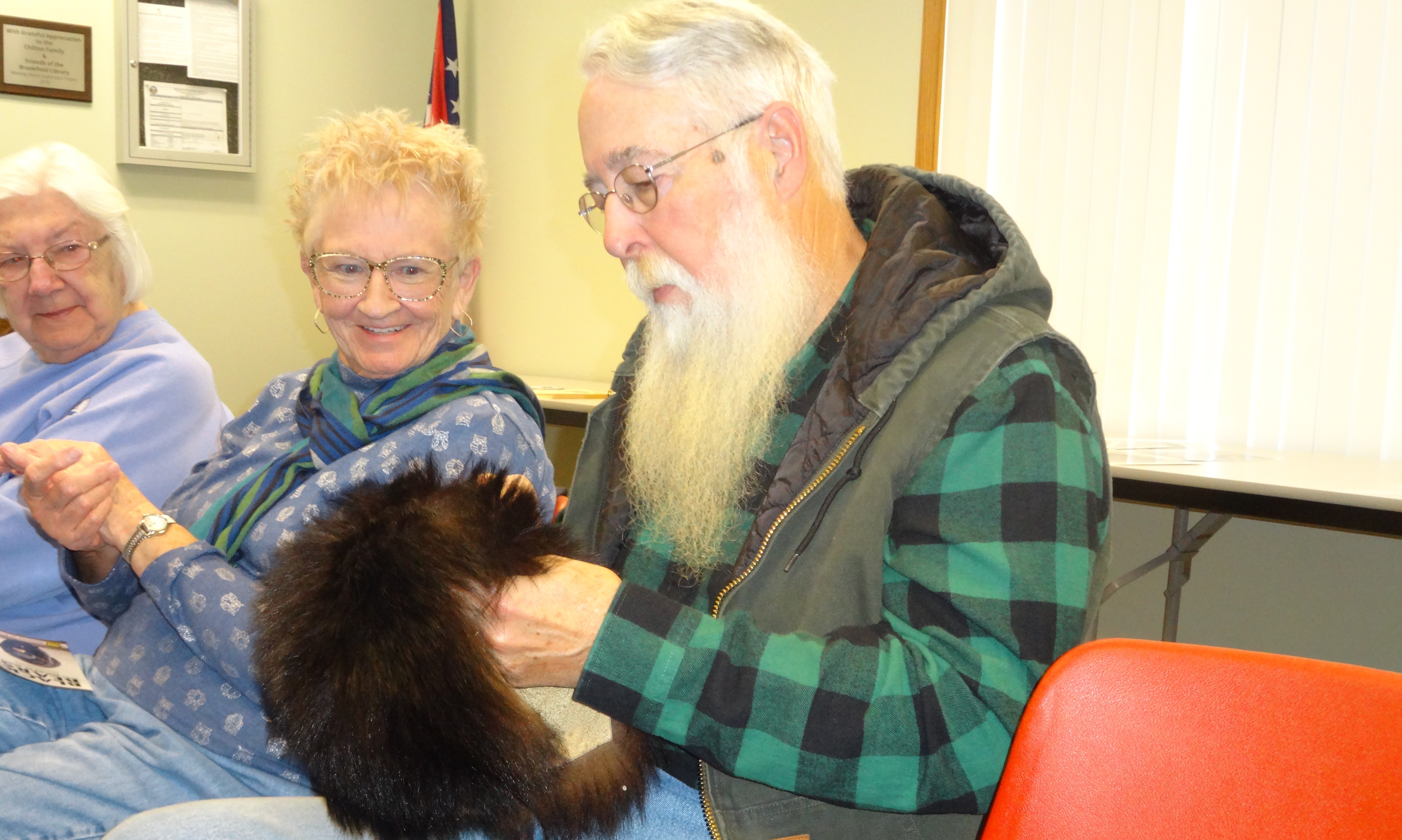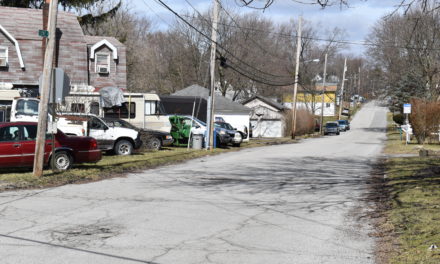Nancy Curry lives on Smith Stewart Road in Vienna Township and “My whole back yard is acres of woods,” she said.
In mid-October, she was looking out her kitchen window and “this big, black, round thing went fast” across her property toward a neighbor’s, where a deer feeder is stationed.
The thing went so fast she didn’t get a clear look at it, but she surmised it was a bear. She keeps looking for a return visit, but hasn’t seen any bears, only “tons and tons of scratch marks” on her catalpa trees and a pile of scat, the fancy term for animal poop.
Curry said she attended the Nov. 6 “Bear Aware” program at Brookfield Branch Library of the Warren-Trumbull County Public Library to try to confirm her suspicion that she saw a bear.
After hearing Amy Reeher describe how bears move, mark territory and eat, “It had to have been a bear, and now I’m sure of it,” Curry said.

Nancy Curry, left, and Amy Reeher.
Reeher, district administrator for Trumbull Soil and Water Conservation District, said bears have been spotted with increasing frequency since 1980, the first time a bear was seen in Ohio since the 1850s.
Most of the bears migrate from Pennsylvania and West Virginia, where the populations are large.
“We get a lot of young males moving over for food and territory,” Reeher said.
Many go back east when it’s time to mate, but Ohio wildlife officials believe there are bears now living in Trumbull County, she said.
“They’ve kind of been all over the county sporadically,” she said, noting sightings in Brookfield, Hartford and Liberty.

Margaret Jean Allison, left, with Anna Marie Shargo and Jim Wherry, who holds a piece of bear hide..
Ohio gets black bears, the smallest of the three species of American bears – the others are the Grizzly and the Polar bear – but the males still can get up to 400 pounds and stand 6 feet tall.
Black bears are “groomed for defense,” but will attack if they are threatened, which is why officials are presenting “Bear Aware.”
“I don’t want you guys to be scared of black bears, but also I want you to have good background knowledge so your interaction, if you ever should have one, is positive and not negative, because that could harm you and the bear,” Reeher told the dozen attendees.
If anyone encounters a bear, these tips are suggested:
* Slowly back away and leave the area.
* Warn the bear you are nearby by talking in a firm, calm voice.
* Make sure the bear has an exit.
* Don’t make eye contact, which would be seen as a challenge to a predator.
Bears generally do not want trouble. “Their goal is to run away and to get away from the situation,” Reeher said.
But, if a bear attacks, fight back, she said. Sometimes a wallop with a stick or a flashlight will be enough to scare it off. Bears also might be warded off by loud noises and clapping, she said.
Signs of aggression in a bear include pawing the ground, popping its jaw and huffing, she said. Standing on its hind legs is not a sign of aggression, no matter what the movies portray, Reeher said.
Don’t ever approach a bear, climb a tree for escape or think you can outrun a bear, she said.
“They are wild animals,” she said. “These are not Pooh bears. These are not Yogi bears.”
Sightings can be reported to the Ohio Division of Wildlife online or by phone, but don’t expect a bear will be relocated just because you notify someone, Reeher said.
“They’re only relocated right now by Division of Wildlife personnel if the animal’s in a situation where escape is unlikely,” she said. “Maybe it’s cornered where there’s a ton of people, maybe during a fair or festival of something like that. It’s a threat to public safety.”
A sociological conflict also could lead to relocation.
“If this is a bear that’s getting habituated to humans, humans are attracted to it or trying to get pictures with it, something like that, it’s probably going to be relocated,” Reeher said.
If the thought of a bear in your back yard gives you the willies, follow these steps to make your area unattractive to them:
* Remove bird feeders.
* Store trash inside or secure the containers.
* Keep pets inside at night and pet food inside at all times.
* Secure beehives with electric appliances.
* Take berries off bushes.
Bears will eat just about anything but are attracted to human food for the same reasons humans are: it contains sugar and is high in fat.
“Sugar and fat bulks us up,” Reeher said. “It bulks them up, too,” which is important in the fall when bears are preparing to hibernate.
Anna Marie Shargo said she attended the program so she would be prepared.
“I wanted to know, if I actually saw a bear, what should I do,” she said. “If I do (see a bear), I hope I’m sitting in my home.”
Jim Wherry of Brookfield said he has been interested in bears ever since that day in about 1966 or ’67.
“I walked in on a hibernating bear,” he said. Although, “They say I never touched the sides coming back up,” the encounter “kind of piqued my interest.”
As for Curry, she’s still on the lookout.
“I’m looking for it every day,” she said.









